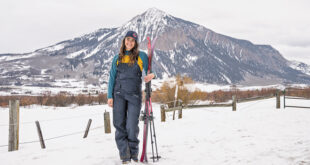story by Dawne Belloise
Brandon Clifford makes his home here in the landlocked mountains of Crested Butte, but his adventures are made spending thousands of hours in diving gear below the waters by distant islands exploring shipwrecks of pirates and ill-fated sailors.
Brandon and his famous father, Barry Clifford, an authority on shipwrecks and a sort of underwater Indiana Jones, recently made international news with the discovery of a 110-pound silver ingot believed to be from the nefarious Captain Kidd’s ship, the Adventure Galley.
The Cliffords’ crew initially discovered the wreck, and several others, in 2000 in a harbor at Sainte-Marie, Madagascar, off the eastern coast of Africa. It’s not the first time the Clifford team has made headlines. In 1984, off the coast of Cape Cod, Barry Clifford finally uncovered the pirate ship the Whydah, which had gone down in a storm in 1717. That discovery sparked a new interest in pirate lore and led to several books and a documentary film.
Brandon explains that they’d been back several times exploring the Ste. Marie harbor, knowing it was what was called a careening area for pirate ships. A careening area was a shallow, sandy beach where the ships would be cleaned of ocean pests like barnacles and worms that were destructive to the ship’s wooden hull. The boat’s bow would be beached and as the tide receded, the vessel would be pulled onto its side with ropes so that the bottom, or hull, could be easily accessed for cleaning.
Brandon adds that these boats had a longevity of only about three years because of the harsh conditions and wood-boring sea worms.
The small island was a safe haven for the pirates to work and take rest from their plundering and they’d hide out there because the locals were friendlier than the mainland residents. There were possibly a dozen famed pirates who spent time there because their vessels were taking on water or they captured a newer, faster ship, in which case they would intentionally sink their old vessel in the harbor in favor of the newly looted one.
The island Ste. Marie inspired many books, most notably Treasure Island. Romanticizing its remoteness is great for books but Brandon notes it’s a difficult place to work as an underwater archeologist for those same reasons, mostly because of all the gear that has to be transported.
The Adventure Galley was built in England as a warship designed by Captain Kidd, who walked a fine line between his sponsored privateering and actual pirating. As a privateer, Kidd was commissioned by the British to fight against the French in the Caribbean and capture pirate ships that were threatening the powerful East India Trading Company.
The vessel was ultimately sunk by Kidd in 1698 when his crew mutinied, took the sails and jumped ship to join Captain Culliford, a brutal pirate, but respected and feared amongst his peers.
“The Adventure Galley was sunk intentionally, so we knew where it was from studying research maps and its history,” Brandon says. “There wasn’t supposed to be much on board, it was supposed to have been completely offloaded, but our scan sonar survey shows that there’s quite a bit of material onboard still. We don’t know exactly what’s onboard. We can theorize. Kidd was secretive, tough, very literate, and very wealthy… he pulled a lot of fast ones,” Brandon says.
“Unless you know what you’re looking for, shipwrecks don’t look like much under water. It was buried in mud and silt so we look for the ballast piles,” Brandon continues, explaining that ballast piles are stones that are placed in the bottom of the ship as a weight to balance it in the water and keep it from toppling over. “We located the ballast pile, and with the four other shipwrecks, we knew what we had because of our extensive research and experience. It’s not like [the shipwrecks] disappear—they’re buried in the mud. Beneath the ballast pile is the frame of the ship. They were made of oak and hardwoods and they’re somewhat preserved under the mud. We’re working by hand, a very slow process since we’re only working a few months at a time in both winter and summer.”
Brandon points out that the best time to be working on the site is actually right now. “We were there last month and it’s getting pretty,” he says of the weather and clear waters.
Working on an eight-part series for the History Channel, Brandon was on the wreck site of the Fiery Dragon—which went down in flames in 1721—recording the progress with the film crew. “We were focused on this wreck, working and filming one square meter at a time. My dad was working on the Adventure Galley site on a one-square-meter test pit, looking for evidence to ascertain the identification of the ship,” Brandon says.
He points out as an example that there was a specific cannonball used on the Adventure Galley. “Dad was digging for two days on this test pit going through the muck and couldn’t see much, when he found the silver ingot. We think there are more. The ingot is so dense, it weighs a lot. We had to pull it out of the hole and then we could feel the markings on it. When we got it out onto the ocean floor we could tell what it was.
“The following day we brought it out of the water and presented it to the president of Madagascar, with the U.K. and U.S. ambassadors, and all the president’s ministers on a stage that was instantly built on the island where we were working. We placed it on the table in front of them, before about 1,000 people. Everyone was shocked and happy. Pirates are a big part of the history of Ste. Marie. Everyone knows this exists and their people are happy when you can find something and tie it into their history. We were all very excited.”
Brandon says there could be another half dozen ships around the island so there could be another 30 years of archeology work. They now have security on the site and archeologists will be heading back to work at the conservation lab, which is in an 1890s colonial building without electricity that currently doubles as a run-down museum. The Cliffords are restoring the building and bringing the place back to life.
The team’s conservators and archeologists are setting up the lab, cataloging artifacts, and getting the facility ready for the crew’s return at the end of August when the work and History Channel filming continues.
Brandon notes that it’s a big project. “At this point, it’s all archeology. It’s a lot of research. But we did it for the story, the experience of it, and the history. We tell the story and retell the history of Captain Kidd.”
 The Crested Butte News Serving the Gunnison Valley since 1999
The Crested Butte News Serving the Gunnison Valley since 1999




